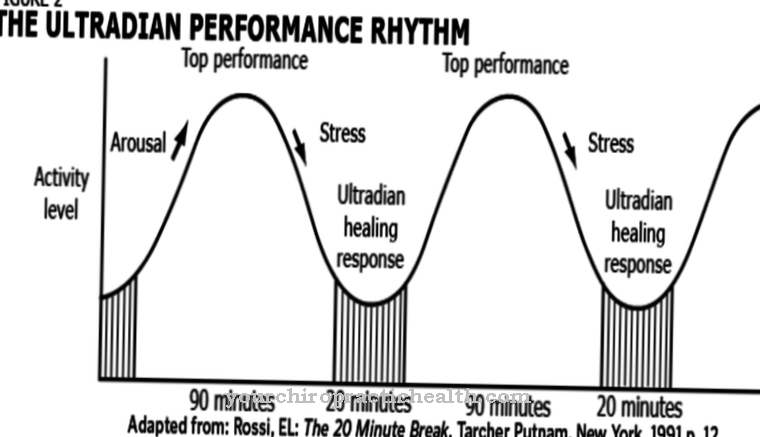In medicine describes the Remyelination a process by which the body partially restores the insulating layer of myelin that normally surrounds nerve fibers (axons). Often the remyelination does not succeed completely, so that permanent damage is possible. Various diseases (for example multiple sclerosis, funicular myelosis or Miller-Fisher syndrome) can affect the myelin sheaths of nerve cells.
What is Remyelination?

Remyelination is a process that, after the loss or damage of the myelin sheaths, aims to restore them.The myelin sheaths arise from the Schwann cells or the oligodendrocytes, which u. a. located on the nerve fibers (axons) of neuronal cells.
Whether Schwann cells or oligodendrocytes serve as the origin for myelin formation depends on where the respective nerve cell is located. While Schwann's cells primarily form the myelin layer of neurons in the peripheral nervous system, oligodendrocytes are primarily responsible for their formation on the nerve fibers in the central nervous system (brain and spinal cord). Both Schwann cells and oligodendrocytes belong to the group of glial cells that make up a considerable proportion of the total mass in the brain.
As it grows, the myelin sheath spirals around the thread-like axon, creating a multilayered layer. A myelin sheath can contain around 50 such wraps. Without the myelin sheaths, the neurons are not optimally able to communicate with one another. This gives rise to numerous problems in information processing. The destruction of the myelin sheaths can be traced back to a disease such as multiple sclerosis or Miller-Fisher syndrome, for example.
Function & task
Remyelination is an attempt by the human body to repair damage to the myelin sheaths and related functional limitations of the nervous system. Often, however, the organism cannot fully compensate for the loss of myelin.
Myelin is a biological membrane that is formed by glial cells and serves as an insulating layer for the nerve fibers of the nerve cells in the central and peripheral nervous system. The nerve fibers are thin extensions of the cells through which information is removed from the cell bodies by means of electrical impulses. When information is passed on to other nerve cells, the electrical impulse travels via the axon to the thickened end knobs, which convert it into a chemical signal. The messenger substances formed reach the next cell through the synaptic gap, where they trigger an electrical signal again.
The insulating layer of myelin improves the transmission: the impulse jumps from one ring to the next.
Damage to the myelin sheath leads to poor electrical insulation of the neurons and thus affects the transmission and processing of information in the nervous system. The remyelination that the human body sets itself in motion is therefore extremely important. However, in severe neurological diseases, it is usually not enough to stop or reverse the course of the disease.
However, medical research sees hope in future therapeutic approaches. Drugs and other treatments could potentially improve natural remyelination.
You can find your medication here
➔ Medicines against muscle paralysisIllnesses & ailments
Remyelination is especially necessary when people suffer from certain diseases of the nervous system such as demyelinating diseases or demyelinating neuropathies.
One of the demyelinating diseases is multiple sclerosis, which is also known under the Latin name encephalomyelitis disseminata. This is a clinical picture that is characterized by multiple inflammation foci in the brain. In areas of the brain that are affected by these foci of inflammation, damage occurs to the myelin sheaths, which electrically isolate the axons of nerve cells. As a rule, multiple sclerosis occurs in attacks, during which patients are particularly affected. More rarely, the disease is continuously worsening. Symptoms that can occur as part of multiple sclerosis include pain, visual disturbances, numbness, and motor disorders such as paresis.
If the disease progresses far, subcortical dementia can develop. The various symptoms manifest themselves due to the disturbed signal transmission in the brain and are therefore extremely diverse. It depends on the location of the inflammation focus which complaints develop. Researchers assume that the immune system plays an important role in the development of multiple sclerosis. So far, however, there is still great uncertainty about the exact causes, so that general statements are difficult to make.
The demyelination diseases also include Miller-Fisher syndrome, which is also associated with demyelination of nerve cells and is a rare form of Guillain-Barré syndrome. The disease can manifest itself in paralysis of the eye muscles, impaired coordination of movements and the complete absence of at least one reflex. As with multiple sclerosis, an inflammatory reaction is also responsible for Miller-Fisher syndrome.
Another example of demyelinating disease is funicular myelosis. Possible symptoms are abnormal sensations (e.g. burning sensation in the hands and feet), impaired coordination of movements, symptoms of paralysis in the legs and psychological symptoms, including depressive or psychotic complaints. In funicular myelosis, the nerve fibers are demyelinated in the spinal cord, which is why there is a risk of paraplegia. The neurological disease is due to a lack of vitamin B12.













.jpg)

.jpg)
.jpg)











.jpg)